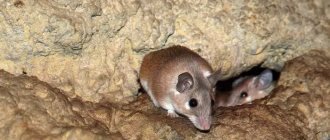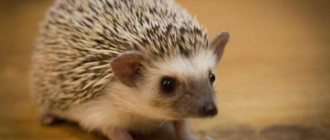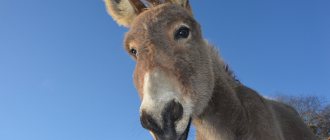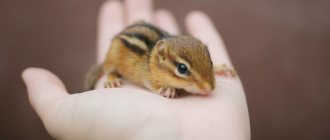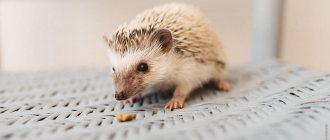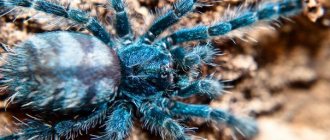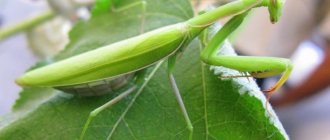Hedgehogs are cute, kind and sweet animals. In addition, they are useful, because living in the wild, they tirelessly fight against malicious pests of gardens and fields, thereby helping people. Hedgehogs are so harmless and funny that many people are happy to keep them at home. Everyone knows what these creatures look like. One of the most striking and characteristic features of their appearance is the presence in adult individuals of sharp spines, which cover almost their entire body, excluding only the pretty face and belly. The thickness of the needles is small, but the length is quite decent and averages 20 mm or more. What does a newborn hedgehog look like? Does it look like its parents? This, as well as many other things concerning these wonderful creatures, will be our story.
When do hedgehogs have offspring?
The natural habitats of hedgehogs are Britain, Ireland, Europe, Scandinavia, the Caucasus and Russia. Hedgehogs can also be found in the Alps, Spain and the Caucasus. Let's consider information about the reproduction of these animals and find out when hedgehogs have offspring?
Reproduction of hedgehogs in nature
Interesting things about hedgehogs:
The mating season begins immediately after hibernation. Like many other animals, among hedgehogs, males fight for the right to mate with a female. During the fight, males bite, push and point sharp spines towards the enemy. At the same time, to create a more menacing appearance, male hedgehogs make a snorting sound. But this is not enough - the winner tries to charm the female for several hours before she finally agrees to let him approach her.
After the mating process, the hedgehogs scatter each in their own direction - the male with a sense of accomplishment, the female to create a hole. A hedgehog can dig a hole with grass bedding, or it can occupy one of the holes abandoned by rodents. The female's pregnancy lasts 49 days, after which 3 to 8 cubs are born. In most cases, 4 hedgehogs are hatched. Despite such a short gestation period, hedgehogs produce offspring only once in a whole year. This is necessary to restore the body and gain strength for the next conception.
Babies are born naked and weighing no more than 12 grams. Needles begin to appear within a few hours after birth. But these are not the sharp needles that we are used to seeing. This is a mixture of white and dark soft needles, the formation of which lasts during the first 15 days of the hedgehog.
Growing up and breeding offspring
The female feeds her offspring for a whole month, after which the hedgehogs slowly begin to live an independent life. During this time, they manage to exchange their generic white needles for darker and sharper ones, they begin to see and orient themselves in space.
The period of teething also begins. Starting from the 5th week of life, little hedgehogs learn to feed on their own, and at the age of 7-8 weeks they are completely ready for independent life.
Source
Reproduction of hedgehogs, care for hedgehogs
Hedgehogs rut twice a year. Moreover, although the female’s estrus lasts 10-14 days, she is ready for productive mating only for 3 days.
Although sexual maturity in females begins at 2-3 months, at this time the female is not yet ready to begin breeding and giving birth to healthy hedgehogs, because her body itself is not yet strong and has not yet fully formed to carry out such a mission.
The act of mating itself is preceded by the process of courtship. And what’s interesting is that the female herself begins to harass the hedgehog. She approaches the male from behind and tries to climb on him. This behavior is a signal that the female is in heat.
The female chases the male for 5-8 days, regularly pinching him and crawling on top of him. And when the time for mating finally comes and when the male can cover her, the female stops and stands with her tail held high and freezes. The male, after a week of pestering the hedgehog, dramatically changes his behavior. It can head butt a defenseless female for 30 minutes to 2 hours or simply crash its needles into her. At this moment, Kasha himself does not even try to defend himself from such “courtship” of his chosen one.
Source
When does your hedgehog hibernate?
How and where do hedgehogs live at home in winter? The future owner of a prickly pet should be aware that even domestic hedgehogs kept in captivity tend to hibernate. Although its duration will be shorter than in natural conditions. If this phase is canceled, the animals may die by spring. This does not apply only to the breed of hedgehogs called African dwarfs - it is not customary for them to hibernate.
In the autumn, the hedgehog requires increased feeding, this is when it accumulates fat reserves. In October and early November, you can observe a period of lethargy and torpor in him, which means the transition to hibernation. For her, the hedgehog should be allocated a secluded place in the house with a temperature of no more than 5 degrees Celsius, preferably somewhere in the attic, in a barn or on a loggia. If the temperature is higher, the hibernation process may not begin. The nest of a domestic hedgehog should be covered with sawdust, dry leaves, rags or straw.
How are hedgehogs born?
In the spring, after the winter frosts have subsided, hedgehogs emerge from their holes. The first warm months: May and June for hedgehogs are the period of mating and reproduction.
The mating season of these small, spiny predators has much in common with the “adult games” of other predatory mammals. Males actively compete for the attention of females - they butt, bite, and generally behave very aggressively. Victory in this battle goes to the strongest.
We invite the forest inhabitants to come to us
If you want these wild animals to visit your site at least occasionally, you can take some actions. Tip #1 - bait. If you attract a hedgehog with food, he will not forget it for a long time, because he is such a glutton. Some facts to note:
- hedgehogs are easily tamed;
- omnivorous;
- quickly get used to a person.
Of course, the first contact with a hedgehog may not be successful. Until the animals recognize your intentions, you will not be able to tame them. At first, they can behave quite aggressively - snort, puff, hiss and puff, and if possible, run away. But as soon as they understand that you do not wish them harm, they will change their anger to mercy.
Pregnancy
Typically, females give birth once a year.
The duration of pregnancy is 42-50 days, depending on:
Before pregnancy, the expectant mother arranges a nest - she pulls off various rubbish, leaves, sawdust, and lays out a hole for them.
During the period before giving birth, the female behaves quite aggressively; she stops eating normally and, basically, only quenches her thirst.
From now on, she is left alone in the home, the male is expelled long before giving birth - due to the lack of parental instinct, he can pose a threat to the offspring. Usually the mother protects her offspring from other predators. Sometimes, this takes on an exaggerated character - if the nest is threatened, the mother, in a panic, may even eat small hedgehogs.
Females give birth to from 2 to 7 babies, usually 4-5, but there are larger exceptions. The hedgehog copes with this process on her own, she usually does not need help from outsiders, and childbirth is not difficult.
The main thing is needles!
The average number of needles on each hedgehog is up to 10,000, and their constant growth and renewal occurs. They are mostly dark in color, sometimes alternating with stripes of a lighter shade.
Depending on the species, a hedgehog can be brown, black, brown, sandy or even white in color. In some places, white and black colors alternate with the formation of spots. Most hedgehogs have well-developed subcutaneous muscles. A characteristic feature of these animals is to curl up into a ball when encountering danger. It is for this purpose that developed subcutaneous muscles are needed, which are located along the line of spine growth.
The hedgehog is a nocturnal animal with poor vision. As compensation, nature endowed him with excellent sense of smell and hearing. This animal cannot be called agile. The hedgehog usually runs away at an average speed of no more than 3-4 km per hour. The hedgehog is a land animal, but most of its species can swim well.
The natural lifespan of a hedgehog is about 3-5 years. If you place a hedgehog in a home environment, then in the absence of natural enemies it can live up to 8-10 years. In nature, its life is shorter. In the forest where the hedgehog lives, he becomes the object of hunting by foxes, wolves, owls, badgers, ferrets, mongooses, jackals, hyenas, eagles and many other predators. And even in the conditions of, for example, a city park, his life is full of dangers.
Birth
After 6-7 weeks of mother’s pregnancy, small hedgehogs are born:
A little later, hedgehogs develop normal spines. They begin to eat solid food and after one and a half to two months they leave their first home. At this age, they are already completely independent, but are not yet adults.
Interesting. At 9-11 months, hedgehogs are fully mature, and their lifespan ranges from 3 to 8 years in the wild; hedgehogs often live longer in captivity - up to 10 years.
Very often, these funny kids, who are so interesting to watch, become pets.
Source
Features and habitat of the hedgehog
There are more than 20 different types of hedgehogs, but they are largely similar and recognizable due to their elongated muzzles on a rather large head for an average-sized hedgehog up to 20 cm long. The beady eyes are very lively and expressive, but they see poorly. But the sense of smell and hearing are excellent, although the antennae on the constantly wet and mobile nose and ears are small.
Many people mistakenly believe that the porcupine and the hedgehog are a group of animals with related ties. In fact, the resemblance is deceptive; hedgehogs' relatives live among moles, shrews and the lesser-known tenrecs and gymnurs. An animal that looks like a hedgehog with its prickly clothes is not always its relative. Thus, a sea urchin is an animal that has no resemblance to a forest dweller, except for the name.
The hedgehog is an insectivorous animal , the average weight of the animal is almost 800 g, but before hibernation it gains weight to about 1200 g. Males are slightly larger in size than females. The hedgehog's front legs are shorter than its hind legs, and five toes on each are equipped with sharp claws. The small tail, up to 3 cm, is almost invisible under the animal’s needle-like coat.
Brownish-light needles up to 3 cm in size, hollow inside. Under each needle there is a muscle fiber that can raise and lower it. Approximately 1-2 needles out of three grow and fall out every year. There is no complete shedding of the fur coat; gradual renewal of the coat occurs over a year and a half. Only sick individuals shed their needles.
The number of spines in one adult hedgehog reaches 5-6 thousand, and in a young animal - up to 3 thousand spines. There are also sparse blond hairs between the needles, but on the belly and head they are thick and darker in color. The gray plain woolen coat is more common, but among the hedgehogs there are white-bellied and spotted species.
Hedgehogs are known to curl up into a spiny ball if danger threatens. This possibility is associated with the work of the circular muscles, the ability to stretch the upper layers of the skin.
Animals can remain in this state for a long time until the threat passes. The needles grow at different angles and form a strong interweaving of spines. Such an impregnable ball.
Animal hedgehogs inhabit only two continents: Eurasia and northern Africa. Despite the similarity of the climate of Europe and North America, hedgehogs are no longer there, although fossil remains indicate a former settlement.
Mixed forests and copses, grassy plains, overgrown river floodplains, steppes, and sometimes deserts are habitats for thorny animals. Only swampy places and coniferous areas are avoided. In the animal world, hedgehogs their territory ; they live alone, mainly in a certain territory, which they regularly explore in search of food.
Hedgehogs are often found near human habitation or economic activity: in park areas, abandoned gardens, on the outskirts of cities and in grain fields. Forest fires, bad weather or lack of food contribute to this.
About certain types of hedgehogs
The entire hedgehog family can be divided into two different subfamilies - true hedgehogs and rat hedgehogs. In total, these animals exist in 7 genera and 23 species. Let's talk briefly about some of their interesting representatives.
1. The most common type of hedgehog is the common or European hedgehog with a body length of about 20-30 cm and a small tail up to 3 cm in size. It weighs about 800 g, and the needles are about 3 cm in size.
The color of such a hedgehog is brownish-brownish with dark crossbars. Where does the common hedgehog live in nature? Representatives of this species are typical inhabitants of plains, parks and woodlands in the countries of Europe, Russia and Kazakhstan. In autumn or spring, hedgehogs slowly shed, replacing approximately a third of all needles.
2. The so-called long-eared hedgehog is distinguished by long ears that grow up to 5 centimeters in size. The representatives of the species themselves are quite small, measuring from 12 to 20 cm in length and weighing about 430 g. The needles of the long-eared hedgehog are short - measuring from 1.7 to 1.9 cm. They are found in dry steppes and semi-deserts, where they try to gather near water sources . The territory where this species of hedgehog lives includes Africa and Asia, Kazakhstan, India, China and Mongolia. In Russia, the long-eared hedgehog can be found in the Volga region and Ural mountains.
3. Eastern European hedgehogs are similar in appearance to European ones, but have lighter fur on the belly and neck compared to the sides and head. An adult can grow up to 35 cm in length, and the weight of a hedgehog over the summer can reach 1.2 kg.
They are found in Germany, Austria and Slovenia, in Kazakhstan and the Urals, as well as on the Mediterranean islands. Their habitat can be very different - parks, copses, garden plots and even river valleys.
4. African dwarf (or white-bellied) hedgehogs are from 15 to 22 cm in length. Their weight is only 350-700 g. With a brown and gray color, the needles of these hedgehogs are white at the tips. All hedgehogs usually snort quietly, but the African hedgehog can make quite loud sounds when in danger. As the name suggests, African hedgehogs live south of the Sahara Desert - in Nigeria, Sudan, Senegal, Ethiopia and Mauritania.
Character and lifestyle of a hedgehog
Hedgehogs are nocturnal animals; during the day they hide among the leaves and windbreaks of bushes, between the roots of plants. They do not like heat and hide in shallow, cool burrows or nests made of dry grass, moss, and leaves. The dimensions of such a dwelling are slightly larger than the size of the owner, up to 20-25 cm. Here the animal takes care of the fur coat on its chest and abdomen, licking it with its tongue.
The long middle fingers help clean the spines whenever possible, which protect against predators but collect ticks and other parasites. Among biologists, there is a concept called hourly, which refers to the number of ticks collected during an hour of movement through the forest.
An acid bath helps get rid of parasites, which is why hedgehogs like to “bathe” in rotten apples or other fruits. Associated with this behavior is the misconception of imagining a hedgehog as an apple eater. The animal's taste preferences are different.
In the dark, a subtle sense of smell helps, vision and hearing contribute. The activity of the animals reflects the route, reaching 3 km per night. Short legs do not allow them to move quickly, but with quick steps, hedgehogs are carried rapidly for their size at a speed of up to 3 m/sec. In addition, hedgehogs are good jumpers and swimmers.
what type of animal a hedgehog is by nature. He is peaceful, but he has many enemies in nature: wolves, foxes, ferrets, martens, kites, eagle owls, vipers. When meeting an enemy, the hedgehog first jumps on the predator in order to prick, and then the ball of needles becomes an impregnable fortress. Having punctured the paws and muzzle, the attacker loses interest in the prey and leaves.
But there are cunning ways to deceive the simple-minded hedgehog. Those animals that eat hedgehogs have the intelligence of a predator. The insidious eagle owl silently attacks and seeks to take its prey by surprise.
Strong scales on the bird's feet protect against prickly pricks. The fox tricks the hedgehog into the water or throws it from a hill into a pond. Having opened its abdomen and muzzle, a swimming animal becomes vulnerable to a predator.
In a duel between a hedgehog and a snake, the fearless prickly animal will be the winner. Grabbing her by the tail and curling into a ball, he patiently pulls her under him. An interesting fact is that hedgehogs are insensitive to many poisons.
The hibernation period takes place in the hole. The body temperature drops and the pulse decreases to 20-60 beats per minute. Awakening occurs in the spring when the air warms up by April. If there is not enough subcutaneous fat, the animal may die of starvation.
Hedgehogs know their areas and protect them from the encroachments of their relatives. Females occupy up to 10 hectares of area, and males occupy 2-3 times more. Their stay is indicated by noisy snorting, sounds similar to sneezing. Baby hedgehogs whistle and quack like birds.
Hedgehog lifestyle
The hedgehog by nature itself is conceived as a solitary nocturnal animal, whose lifestyle is rather secretive. Usually in the mink where the hedgehog lives (its length can reach 1 meter), he sleeps throughout the day. Those populations that live in foothill areas can hide in voids under stones and crevices between rocks.
In the area near the burrows where hedgehogs live, they go out to hunt at night in the summer. Unfortunately, according to statistics, a very large number of them die under the wheels of cars when trying to cross roads in the dark.
Hedgehog food
Hedgehogs' diet is based on animal food, consisting of beetles, earthworms, frogs, mice, shrews, and lizards. The prickly resident feasts on various insects and their larvae, snails, slugs, and can destroy a bird’s nest with eggs or hatched chicks.
In general, gluttony and omnivorousness are explained by activity and the need to store subcutaneous fat. Hedgehogs are toothy animals: 20 upper and 16 lower teeth help them cope with a wide variety of foods. Berries and plant fruits can be an addition to animal food.
Hedgehogs especially need food after emerging from hibernation. To restore strength, the animal can eat up to 1/3 of its weight overnight. In captivity, hedgehogs willingly eat meat, eggs, bread, ice cream and even oatmeal. A misconception is the idea of a hedgehog as a lover of sour cream and milk. Such food is contraindicated for him due to lactose intolerance.
Reproduction and life expectancy of a hedgehog
The mating season begins in the spring, after hibernation, or in the summer. Males fight for the female through local fights: they bite, prick themselves with needles and sniffle menacingly at each other. There are no special rituals; the winner finds the female by smell.
After mating, pregnancy lasts on average from 40 to 56 days. Cubs appear only once a year. There are usually 4 hedgehogs in a litter. Babies are born completely helpless, blind and naked.
In the photo there is a newborn baby hedgehog
But after a few hours, protective needles appear on the pink skin. At first they are soft, but within a day the prickly cover hardens and grows. The development of hedgehogs is such that they first become covered with a protective coat, then learn to curl up into a ball, and only then open their eyes.
Up to a month, the cubs are fed with mother's milk. The female and her babies live in a secluded den made of collected leaves and brushwood. If someone discovers the nest, the hedgehog takes the offspring to another safe place. Hedgehogs begin to lead an independent life at about two months of age, but finally leave their native den in late autumn. Sexual maturity occurs at 12 months.
The life expectancy of hedgehogs in nature is short, 3-5 years. The reason lies in the large number of predators. In captivity they live longer, up to 10-15 years. But animals are not adapted to being kept at home.
It should be taken into account that they are nocturnal, noisy and completely resistant to training. Experience therefore dictates that hedgehogs are not recommended pets. Many people consider hedgehogs to be useless animals for humans. But what kind of animal is the hedgehog, nature itself judged, generously dispersing them around the world.
Source
Care at home
If for some reason the babies are left completely without maternal warmth and affection, then the caring owner has to take on all the functions and responsibilities of the hedgehog. It should be remembered that for such babies, massage performed before and after each feeding is very useful. It is better to carry out this procedure using cream for newborns. For a newly born hedgehog, this replaces the mother's licking, which is necessary for its healthy development and calmness, but most importantly, stimulation of the intestines. For massage, small cotton balls are required. They are moistened with oil. And then you should make careful stimulating movements, tickling and soft, in the tummy area and at the base of the tail.
It is better to carry out control weighings of babies every day and keep records. It should not be forgotten that in nature, the hedgehog does not leave their cubs for the first days of life for a minute, feeds them with nutritious and tasty milk, and warms them with maternal warmth.
What does a hedgehog look like?
An ordinary hedgehog looks quite small, because its size is small. This prickly animal has a body length of 20-30 cm and a very short tail of 3 cm, which is invisible under its fur coat. The body weight of the common hedgehog is 700-800 g. Females are slightly larger than males in size.
The hedgehog looks funny. It has small ears, the length of which is 3 cm. The European hedgehog has a large head with an elongated muzzle, on which there are small, beady black eyes. One of the features of what a hedgehog looks like is its sharp and always moist black nose.
But, despite such a cute and funny appearance, the common hedgehog can boast of having small but sharp teeth. He has 20 of them on his upper jaw, and 16 on his lower jaw. The European hedgehog also has sharp claws on its paws. Each of its paws contains 5 fingers. The hind limbs of the hedgehog are slightly longer than the front ones.
And of course, the most important distinguishing feature of a hedgehog is its spines. Thanks to them, the hedgehog doesn't look so harmless. Surely everyone has wondered, how many spines does a hedgehog have? So, usually an adult hedgehog has 5-6 thousand spines. Young hedgehogs have about 3 thousand spines.
The common hedgehog has short spines, no more than 3 cm long. The hedgehog's spines have a smooth surface, are empty inside and filled with air. They are brown in color with dark and light transverse stripes. Due to this coloring of its prickly coat, the hedgehog looks quite inconspicuous.
The hedgehog's spines on the head and sides are shorter and 2 cm long. Between the spines there are very sparse and thin hairs. The head and belly of the hedgehog are covered with coarse and dark hair.
The paws, muzzle and belly of European hedgehogs range in color from whitish-yellow to deep dark brown. The chest and throat of the hedgehog have a uniform color, without different white spots.
Jerzy: who are they?
These creatures belong to the order of insectivores. Their body length is on average 25 cm. Their weight is also insignificant, usually no more than 800 g. Hedgehogs have a wedge-shaped head, an elongated muzzle and a sharp nose, wet to the touch. The forelimbs of these creatures are shorter than the hind limbs. Each of the four paws has five fingers equipped with sharp claws. The length of the ears of such mammals depends on the species. They are usually small, measuring just over 3 cm, but in Cyprus hedgehogs this part of the body is somewhat larger. There is a short tail at the back. Parts of the body not covered with needles usually have a variety of colors from dark brown to light yellow.
Such animals are very common in Europe. They live in small forest clearings and river valleys, sandy areas and grassy plains. Hedgehogs often inhabit areas in close proximity to human habitation, are found in gardens and parks, and hide in the grass and bushes.
Where does the hedgehog live and how?
The common hedgehog lives in Western and Central Europe, the British Isles, southern Scandinavia, northwestern European Russia, Western Siberia and Kazakhstan. The common hedgehog also lives in New Zealand, where it was introduced. This insectivorous animal is most widespread in Europe, Western Siberia, northwestern Kazakhstan, Asia Minor, Amur region, northern and northeastern China.
The hedgehog lives in different places, but avoids large swamps and dense coniferous forests. The hedgehog lives preferring forest edges, copses and small clearings. In Europe, the common hedgehog can be found in mixed forests, shrubs and grassy plains. Also, a hedgehog often lives next to a person. Therefore, finding a hedgehog in a city park or in a country house is a common occurrence.
Hedgehogs live by being active at night. During the day, hedgehogs live in their nests, where they can rest comfortably. Hedgehogs make their nests in bushes, holes, tree roots or empty rodent burrows.
Typically, a European hedgehog's nest is 15-20 cm in diameter and has a flooring of dry grass, leaves and moss. In such a nest the hedgehog sleeps and can take care of itself. With the help of their paws, hedgehogs take care of their prickly fur coat, and they lick their chest and belly with their tongue.
Also, hedgehogs each live in their own area, where they wander in search of food. During the night, the common hedgehog runs up to 3 km. Males show aggression among themselves and protect their territory. They snort noisily and make various sounds similar to sneezing.
The area of the site for males is 7-39 hectares, and for smaller females it is 6-10 hectares. Even though hedgehogs have a prickly coat, they also shed. In ordinary hedgehogs this usually occurs in spring or autumn. This process is very long and slow. Each new needle grows for 12-18 months.
The small size of the common hedgehog does not prevent it from being quite nimble. These animals can run at speeds of up to 3 m/s, and they are also excellent swimmers and jumpers. Hedgehogs have poor eyesight, but they have a very keen sense of smell and sensitive hearing.
In the summer, the hedgehog prepares for winter and accumulates fat reserves for the winter. In addition to his usual weight, he also gains 500 g of fat, because in winter the hedgehog hibernates. Hedgehogs spend the winter in their burrows. When frosts come, European hedgehogs hibernate, tightly closing the entrance to their burrow. Hibernation usually lasts from October to April.
During hibernation, a hedgehog's body temperature drops to 2 °C. Over the summer, the hedgehog must gain as much fat as possible, because if it hibernates without the necessary supply of fat, it may die of starvation in the winter.
After hibernation, this insectivorous animal does not immediately leave the nest, but waits until the air temperature rises to 15 °C. Common hedgehogs live alone, but settle close to each other. Adults avoid close contact with each other, with the exception of mating season. How many years do hedgehogs live? In nature, hedgehogs live 3-5 years, but the life expectancy of a hedgehog in captivity can reach 8-10 years.
Why do I eat needles? Everyone is familiar with the ability of hedgehogs to curl up into a prickly ball if danger threatens. This animal can remain in this state for a long time until the threat passes. The hedgehog's spines form a strong armor. Therefore, the hedgehog needs needles for protection.
But hedgehog spines require careful care, because the spines collect ticks and other parasites. The paws help the hedgehog clean its thorns. But since they are short, the hedgehog cannot reach everywhere to clean properly.
In such cases, the acid released by the fruit helps get rid of parasites. That's why hedgehogs ride on rotting apples or other fruits. This behavior makes one mistaken in thinking of the hedgehog as a passionate lover of apples, who pricks them on needles and carries them on his back to his hole. But this is not so, the hedgehog prefers insects.
The hedgehog is a peace-loving creature, but it has plenty of enemies in nature. Wolves, foxes, eagle owls and other predators threaten the life of the hedgehog. Having met a predator, the hedgehog first jumps on it to prick it, and then curls up into a ball. Having pricked its paws and muzzle, the predator loses interest and retreats.
But the enemies are cunning and are able to deceive the simple-minded hedgehog. Especially those that feed on hedgehogs. The eagle owl attacks unexpectedly and silently, trying to take the hedgehog by surprise. The bird's paws are protected by thick skin from the hedgehog's prickly needles. The fox drives the hedgehog to the water or throws it from a hill. In such situations, the hedgehog opens its abdomen and muzzle, becoming vulnerable to predators.
But in a duel between a European hedgehog and a snake, the prickly and fearless daredevil becomes the winner. The animal grabs the snake and curls up into a ball, gradually wrapping it around itself. After all, he is insensitive to many poisons.
Is it safe to interact with these animals?
As it turned out, hedgehogs evoke affection not only because of their appearance, but also because of their usefulness. They command respect from summer residents because they eat pests. Therefore, when a meeting between a hedgehog and a person occurs, people usually with the warmest feelings try to feed him and get to know him better. Before adding a hedgehog to your household, find out more about these animals. Being close to hedgehogs can also pose some danger:
- may bite;
- are carriers of parasites;
- can infect humans.
Hedgehogs bite quite painfully and unpleasantly . They have real teeth. This animal is not domestic at all, but wild; you never know what infections it can introduce into your blood by biting. Therefore, if you decide to take a forest dweller in your hands, it is better to use thick gloves ; at least he will not bite them. As a consequence of the bite, an abscess may become inflamed in this place, which will be quite difficult to remove.
Encephalitis and Lyme disease can also come from this cute little animal. This happens because hedgehogs are inhabitants of forests and plantings, and ticks and fleas are most often found there. Because hedgehogs have spines on their backs, they scratch them off on themselves. They can parasitize for quite a long time, and the animal is already sick.
In addition, cute and harmless creatures can infect people with helminths or, in other words, worms. They cause severe poisoning and serious illness in the body. Therefore, after contact with hedgehogs, thoroughly wash the dishes with which they ate, and, of course, your hands. This animal can also infect humans with the rabies virus At the same time, from the external signs of a hedgehog this is absolutely imperceptible. Often they suffer from unactivated rabies, but it has already begun to progress in the body. However, this type of virus paralyzes the nervous system and the animal itself, causing death.
Take precautions. Regardless, take precautions when handling hedgehogs, especially when children touch or play with them. However, you should not shy away from these animals. It is also not necessary to drive them away when you see them on your farm. Try not to squeeze them and it’s better, of course, not to pick them up. So remember:
- if you pick up a hedgehog, wear gloves;
- if he runs into the house, cover him with a bucket and take him outside;
- wash your hands and bowls from which he has eaten;
- do not allow contact with pets.
Hedgehogs already do a lot of useful things; you don’t have to squeeze them, because they are not pets at all, but inhabitants of the wild. However, if you decide to take care of a random guest, no one forbids you to feed him.
What do hedgehogs eat?
The common hedgehog is an insectivorous animal. But the hedgehog's diet is not limited to insects. Hedgehogs mainly feed on a wide variety of insects, caterpillars, beetles, slugs, earthworms and also mice. It is quite rare for hedgehogs to get mice and voles.
Hedgehogs also eat eggs or chicks of small birds that make nests on the ground. Sometimes in nature, hedgehogs feed on reptiles and amphibians. Hedgehogs also eat berries and fruits. Therefore, we can safely say that the hedgehog is an omnivore. The only thing a hedgehog cannot eat is dairy products, as a hedgehog cannot digest lactose.
baby hedgehog
After hibernation, hedgehogs begin mating season. Hedgehogs become capable of reproducing at the age of 10-12 months. Males often fight for females. They bite each other's paws and snouts, push each other and stab each other with quills in battle. In a fight, hedgehogs snort and sniff loudly.
After the battle, the winner tries to impress the female and circles around her for hours, attracting attention. Hedgehogs do not form pairs and the female takes care of the young on her own. As a den, the hedgehog digs a hole or occupies empty rodent holes. A flooring of dry grass and leaves is arranged in the hole.
The female European hedgehog gives birth to offspring once a year. Pregnancy lasts a little more than 1.5 months. Usually 3-8 baby hedgehogs are born, but most often 4. Baby hedgehogs are born blind, and their bright pink skin has no spines or fur. The body weight of a baby hedgehog is only 12 grams.
In just a couple of hours from the moment of birth, hedgehogs develop soft spines that harden within 2 days. A baby hedgehog acquires a fully formed quill cover by the 15th day of life. At the same time, the baby hedgehog opens its eyes and begins to learn to curl up into a ball.
The female is with the babies in her den. If someone discovers the nest, the mother takes the hedgehogs to another place. Milk feeding lasts 1 month. When the feeding period ends, the hedgehogs learn to live independently. Already at 2 months they become much more mature, but they finally leave their native den in the fall.
In a few days
During the first day of their existence, babies continue to remain blind and deaf. But they grow quickly and very soon become completely different from what they were born with. Hedgehogs at a week old rapidly gain weight and weigh about 40 g. They start fussing and playing with their brothers and sisters, fighting both jokingly and seriously. This activity strengthens their muscles, promotes healthy muscle development and coordination of movements.
Babies make clicking noises and squeaks. These signals, the spectrum of which is very diverse, in natural conditions serve as signs for the mother, which helps her understand the condition of the children. Having reached 11 days of age, little hedgehogs learn to curl up into a ball. During this period, they should receive 3 milliliters of milk per feeding. It is necessary to keep their nest clean and change the litter regularly. And the temperature in the baby’s home should not fall below 35 °C. You cannot overfeed such pets. Hedgehogs have no sense of proportion and are capable of eating to death. And this is not an exaggeration at all.

